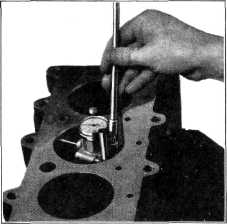1942 - 1947 CHEVROLET SHOP MANUAL
Section 6 - Engine
|
|
|||
|
6-3 |
|||
|
|
|||
|
frame it is
not possible to remove the reactionary lever assembly from the transmission
operating shaft while the
assembly is in the car. To remove the Cabriolet engine, follow instructions
given above in Paragraphs 1 through 10, then:
Disconnect the vacuum cylinder
piston rod and valve link from the
reactionary lever system.
NOTEŚReplace the clevis pin
through the piston rod yoke and valve link to prevent upsetting the vacuum
valve adjustment.
Then
proceed as instructed in paragraphs 13 through 17.
REPAIR OPERATIONS
PISTONS
Chevrolet
pistons are cast iron surface treated, with a slipper skirt. Three ring grooves are
located above the piston pin.
The pistons are of unusual design, being cam ground out of round. This
out-of-round design compensates for heat expansion along the line of the piston pin bosses.
The truck engines use a
heavier and more rigid piston than the passenger car engines. The truck piston
may be identified by a small
forged boss on the lower center
of each piston pin boss. Since the truck piston is heavier than the
passenger piston, passenger or
truck pistons must be used in sets, and the two different types must not be used in
the same
engine.
The lower
piston ring on the piston is an oil control ring with ports to allow excess
oil, scraped from the sides of
the cylinder walls, to be returned to the inside of the pistons and
then to the Crankcase, by means
of holes drilled in the ring grooves of the piston.
Chevrolet
pistons are furnished in standard size as well as .003", .010", .020", .030" and
.040" oversizes.
When
necessary to replace pistons, due to wear, the cylinder walls should be honed for
.003" oversize or rebored
and honed for .010", .020", .030" or .040" oversize
pistons.
NOTEŚAny time a piston is
removed from the cylinder, it should
be examined for carbon on the inside. Chevrolet pistons do not
carbon up excessively: however, it is a good practice to inspect them and
remove any carbon that is present. This helps to keep the engine oil
clean.
Checking Cylinders
By far the
best method to be used in determining the condition of the cylinder in an
engine preparatory to reconditioning is the use of a dial gauge such as is shown in Fig.
2. |
The dial
gauge hand will instantly and automatically indicate the slightest variation
in the cylinder bores. It
completely eliminates uncertainty and possible mistakes in
judgment.
In use, the dial gauge is simply
inserted in the cylinder bore, and
moved up and down its full length. It is then turned spirally or
completely rotated at as many points as may be desired,
taking readings at each
point. In this manner, all variations in the cylinder walls from top to
bottom may be
determined. |
||
 |
|||
|
Fig. 2ŚChecking Cylinder Sore with Dial Gouge
If a master gauge, corresponding
with the exact diameter of a standard
size cylinder bore, is used to
set the dial gauge, it is easy to determine the oversize piston to use as well as the amount
of metal which must be removed
from the cylinder walls to make
them true.
Cylinder Boring
When it
becomes necessary to rebore the cylinders of an engine to fit oversize pistons,
the instructions furnished by the manufacturer of the
equipment being used should be
very carefully followed.
Before
using any boring bar the top of the cyl-der block should be filed off to remove any
dirt or burrs. This is very
important, otherwise the boring bar may be tilted which would result
in the rebored cylinder wall not being at right angles to the crankshaft.
In Chevrolet engines the piston
clearance is provided for on the
piston and this must be taken into consideration when setting the cutter
in the boring bar. The piston
to be fitted should be checked
with a micrometer, measuring just below the lower ring groove and at right angles to
the |
|||
|
|
|||